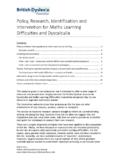Transcription of Dyscalculia Screener
1 Dyscalculia Screenerby Brian ButterworthHighlighting pupils with specific learning difficulties in mathsAge 6 14 yearsCopyright Brian Butterworth 2003 All rights reserved, including translation. No part of this publication may bereproduced or transmitted in any form or by any means, electronic or mechanical,including photocopying, recording or duplication in any information storage andretrieval system, without permission in writing from the publishers, and may notbe photocopied or otherwise reproduced within the terms of any licence grantedby the Copyright Licensing Agency by nferNelson Publishing Company Limited,The Chiswick Centre, 414 Chiswick High Road, London W4 5TF, : 020 8996 8444 Fax: 0845 6015351 Internet.
2 Is a division of Granada Learning Limited, part of Granada plcPrinted in Great Britain by Ashford Colour Press, : 0090008620 ISBN: 0 7087 0366 6 2( )iiiContentsChapter 1: What is Dyscalculia ?..1 Definition of Dyscalculia specific to this Screener ..3 Experiences of Dyscalculia ..5 Chapter 2: Diagnosing Dyscalculia why this Screener is 3: How the Dyscalculia the Screener was developed ..11 Individual subtests: rationale/virtues ..14 Chapter 4: Using the Dyscalculia and why to use ..19 Getting started ..20 Installation ..22 Adding pupils to the pupil details and reports.
3 27 Sitting the test ..28 Glossary of terms ..30 Chapter 5: Scores and how to use 6: Next to do if the Dyscalculia Screenerproduces a diagnosis of dyscalculic to do if the Dyscalculia Screenerproduces a diagnosis of dyscalculic tendencies with compensatory aspects ..38 What to do if the Dyscalculia Screenerproduces a diagnosis of low achievement ..40 Appendix 1: Summary of research leading to the definition ofdyscalculia specific to this ..41 Problems encountered by pupils with Dyscalculia ..42ivUnderlying processing deficits ..44 Subtyping Dyscalculia .
4 47 Evidence for the independence of mathematical abilities ..50 Appendix 2: Standardisation results ..54 Derivation of the standardised scores ..57 Inter-correlations between individual tests ..59 Appendix 3: Retrieving data files for research 4 : Where to go reading ..64 Useful websites ..65 Useful organisations ..65 Specialist schools ..65 Useful software ..66 Appendix 5: of figures, tables and chartsFigure 1: The normal score distribution showing the relationship between stanines and standardised 1: Number of pupils in specific year groups who were administered Mental Mathematics 2: Number of pupils in specific year groups who were administered the Dyscalculia Screener .
5 54 Table 3: Average percentage of questions the pupil answered correctly, according to age and 4: Pearson correlations of the stanines for each possible pair of test Chart 1: Simple Reaction Time median from 2: Dot Enumeration reaction time median 3: Numerical Stroop reaction time median 4: Addition reaction time median from 5: Multiplication reaction time median from I am grateful to Dr Manuela Piazza for help in developing theDyscalculia Screener . Anna Bevan co-wrote Appendix 1 andinterviewed children and teachers about the consequences ofmathematics disabilities.
6 Jo Winters and her colleagues in theLondon Borough of Harrow Education Authority and Fairley HouseSchool provided an invaluable opportunity to evaluate the approachtaken here. I thank the Department for Education Skills SEN SmallGrants Programme for supporting some of the research reportedhere. Dr Lindsay Peer CBE of the British Dyslexia Associationprovided encouragement and guidance. I would also like to thankNick Nelson (CFAS, University of Manchester) and Cres Fernandes(nferNelson) for their contributions to the ButterworthThe publishers would also like to thank Di Hillage of the BritishDyslexia Association Computer Committee.
7 Vi1 What is Dyscalculia ? Dyscalculia is sometimes called number blindness. It is the name givento the condition that affects our ability to acquire arithmetical is a complex subject, involving language, space andquantity. Much research into the development of mathematical skillshas focused upon counting or arithmetic, but even at early levelsmany complex abilities are involved in these skills, including: understanding number words (one, two, .. twelve,..twenty, ..), numerals (1, 2, .. 12, .. 20, ..) and therelations between them; being able to carry out mental arithmetic using the four basicarithmetical operations addition, subtraction, multiplicationand division; being able to carry out written multi-digit arithmetic usingthe four basic operations; being able to solve missing operand problems (?)
8 4 6); being able to solve word problems which set arithmeticalproblems in realistic contexts, particularly using money complexity of numerical processing has made defining what itmeans to have a specific mathematical learning disability( Dyscalculia ) difficult. Traditional definitions state that the pupil must substantially underachieve on a standardised test relative tothe level expected given age, education and intelligence, and mustexperience disruption to academic achievement or daily achievement tests, however, generally test a range ofskills, which may include spatial and verbal abilities, beforecollapsing the total into one global score of mathematicsachievement.
9 In addition standardised tests are diverse, so what ismeant by mathematics achievement may vary substantially1between tests. For this reason it has been hard for researchers topinpoint the key deficits in Dyscalculia , or to be sure how to definedyscalculics for study. A range of terms for referring to developmental mathematicsdisability has emerged, including: developmental Dyscalculia or DC (Shalev and Gross-Tsur,1993; Temple, 1997); mathematical disability (Geary, 1993); arithmetic learning disability : AD, ARITHD, or ALD (Gearyand Hoard, 2001; Koontz and Berch, 1996; Shafrir and Siegel,1994; Siegel and Ryan, 1989); number fact disorder or NF (Temple and Sherwood, 2002); psychological difficulties in mathematics (Allardice andGinsburg, 1983).
10 As Geary (1993) and Geary and Hoard (2001) remark, these differentclassifications seem in most cases to describe the same term Dyscalculia will be used in this manual, but is intended torefer to all these Diagnostic and Statistical Manual of Mental Disorders, fourthedition (DSM-IV), which is the standard US psychiatric handbook,gives the following diagnostic criteria for Mathematics Disorder :Mathematical ability, as measured by individuallyadministered standardised tests, is substantially below thatexpected given the person s chronological age, measuredintelligence, and age-appropriate education, whichsignificantly interferes with academic achievement oractivities of daily living that require mathematical ability.
